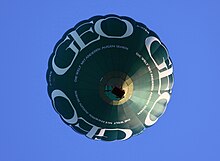Entire advertising


The wrap advertising , also wrap advertising , full advertising , full advertising , Total advertising , totalwerbung , Popreklame or Popwerbung called, is a special form of transport advertising , in which the outer side of a means of transport is entirely used as an advertising space.
Full advertising is used in particular on vehicles and cars for public transport such as buses , trams and trains, but also on ships and airplanes . In addition, taxis , rental vehicles and private vehicles are increasingly being advertised in full.
history
Full advertising on means of transport was already in use in the 1930s. End-of-life vehicles, e.g. decommissioned trams or work cars , were completely provided with advertising space. The outside of these so-called advertising trams was covered with either panels or fabrics for this purpose. In addition to advertising for consumer goods, these moving advertising pillars also featured propaganda for political parties. In Hanover, the Üstra transport company first used tram cars with full advertising from 1969. They advertised regional dairy products.
techniques
The following techniques (as well as the resulting mixed forms) are used to apply full advertisements:
- Painting
- Foiling
- labeling
- additional structures and other elements such as flags, loops, etc.
Furthermore, a distinction must be made between a partial and a full design. In the case of partial designs, the window areas usually remain free. The full design, on the other hand, provides for the full-surface attachment of advertising space, including the window areas. This technique was made possible by the development of partially transparent foils. These special foils enable the people inside to see outside with restrictions. Among other things, perforated window foils, partially printed transparencies and contour-cut "foil plots" (also called "plotted foils") are used.
criticism
From the passenger's point of view, full advertising is rather questionable. The surroundings are more difficult to see from the (moving) vehicle; Travelers can get lost.
See also
- Full vehicle wrapping - covering a vehicle with film for advertising or design purposes

